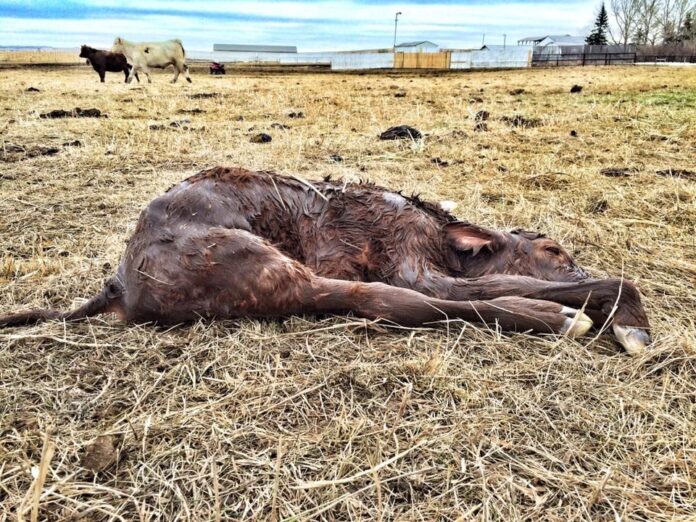Calving Tips/Advice for Farmers
In this news article, That’s Farming, looks at the calf recovery position, how to resuscitate calves, why you should not hang calves over gates, the power of baby powder and the Madigan squeeze.
Calf recovery position
The first thing to do is put that calf in the calf recovery position, which involves it up on its chest and pulling its back legs up towards its armpits.
This allows both of those lungs equal opportunity to expand and fill with air and putting those legs forward means that the calf is stable.
It cannot just flop back over onto its side, as Dr Claire Windeyer DVSc explained.
Dr Cody Creelman’s image demonstrating the best practice of the calf recovery position is a commonly shared post across social media.
On his Facebook page, which has over 230,000 followers, he wrote: “Calving season reminder: this is the best possible calf recovery position after birth.”
“Put the calf on its chest, with its back legs pulled towards its ears. This allows for maximal oxygen perfusion of both lungs and opens the upper airway.”
“It is called the ‘Calf Recovery Position’ by you can call it the ‘Cody Creelman’ if you’d like,” he posted.
Do not hang calves over gates
This is something that some farmers have done traditionally, but vets strongly advise against this.
Dr Claire Windeyer DVSc, associate professor, production animal health, University of Calgary, explained the dangers of doing so:
“Unfortunately, this fluid is not coming from the lungs like people always believed. It is actually mostly coming from the stomach, so it is not achieving what we think it is.”
“The other thing that it does do, though, is gravity is then pushing the abdominal content, so the intestines of the calf, down against the diaphragm, actually making it harder for those lungs to expand,” she added.
Read an article on how to resuscitate calves.
Calf Resuscitation: Water and/or poky blade of straw
If a calf does not breathe straight away, we can then simulate it by rubbing it vigorously.
As Dr Windeyer advised, “we can stick a finger in its ear and/or we can pinch the nose and give their head a little shake”.
Use a piece of poky straw to poke the nasal septum, which is that piece of tissue that separates the two nostrils on the inside.
You could splash some water on the back of the calf’s neck or its face or squirt a small quantity of water into the ear, but beware, you can create ear infections if you do not do so gently.
“This tricks the body into thinking that the calf might be drowning. So, they gasp, and they fill those lungs with air,” she explained.
The Madigan Squeeze
John Madigan, DVM of the University of California, Davis, developed the Madigan squeeze technique to help foals suffering from neonatal maladjustment syndrome (often referred to as ‘dummy’ foal syndrome) to recover.
That’s Farming previously highlighted this technique after Cavan-based vet, Gerard McGovern, performed the procedure on a non-sucking calf.
He explained that many of these calves are “bright and lively but just won’t suck the cow’s teat”.
“By mimicking the birthing process – by squeezing on the foal/calf’s thorax for approximately 30 minutes with a soft rope – the brain is rebooted, and with some luck, the calf/foal will be up sucking after the procedure,” McGovern outlined.
We also shared a case of a calf born backwards which was “limp like a rag doll” for the first 24 hours – read more in this news article.
Baby powder
Last year, we published an article on a farmer across the waters in California who “swears” by using baby powder to help adopt calves onto foster cows.
On Facebook, Celeste Settrini penned a post about what she describes as a “really simple way” to bond a cow and calf.
She says that “every year I have to bring out the baby powder”, and it seems like it “never” fails.
She explained further: “Today, we had a cow who lost her calf, and around our place, we always have an extra calf or two through our cows calving twins.”
Read this article.
See more farming news on That’s Farming.





